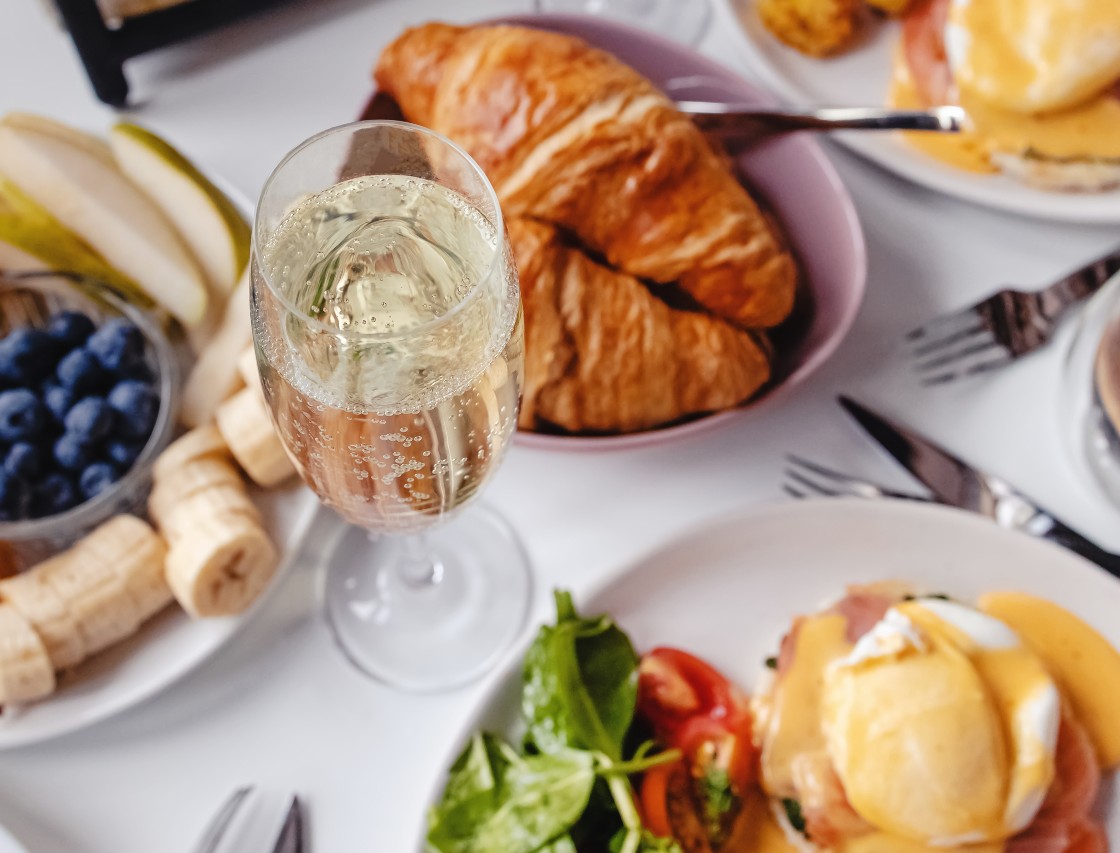


There’s something undeniably enchanting about a leisurely Sunday morning, sipping bubbly and savoring breakfast dishes well past the conventional breakfast hours. We have our favorites dishes that pair beautifully with bubbly, but below are just a few Champagne brunch menu ideas to ensure maximum enjoyment.
But first… the history of this fabulous meal.
Like many culinary traditions, the origins of brunch are fuzzy. Some food historians trace it back to England’s smorgasbord-style hunt breakfasts; others attribute its genesis to Catholics who indulged in hearty midday feasts after fasting for morning Mass. However, the credit for the modern concept of brunch is widely bestowed upon an English author, Guy Beringer, who introduced the idea in an essay called “Brunch: A Plea” in 1895.
Beringer envisioned brunch as a time for delectable food and delightful company. It was meant to spark joy, as Beringer eloquently stated, “By eliminating the need to get up early on Sunday, brunch would make life brighter for Saturday-night carousers. It would promote human happiness in other ways as well. Brunch is cheerful, sociable, and inciting. It is talk-compelling. It puts you in a good temper, it makes you satisfied with yourself and your fellow beings, it sweeps away the worries and cobwebs of the week.” Most importantly, he foresaw replacing traditional breakfast beverages with alcohol, an idea that still resonates.
In the United States, the term “brunch” made its debut in an 1896 edition of a Pennsylvania newspaper, the New Oxford Item, describing it as “the latest ‘fad’, which quickly gained popularity. During prohibition, brunch became associated with daytime drinking culture. Cocktails, cleverly disguising alcohol with juices and sweet mixers, became the stars of brunch, leading to the creation of iconic brunch cocktails like the Bloody Mary, Bellini, and Mimosa. My grandfather drank Champagne out of teacups with brunch at the Jonathan Club in Los Angeles.
The 1930s marked the nationwide explosion of brunch, with The New York Times declaring Sunday “a two-meal day.” Brunch was served during transcontinental train trips, with a customary stopover in Chicago for a glamorous late-morning meal. It was a hit at famous establishments like the Pump Room in Chicago’s Ambassador Hotel, where brunch became as much about the scene as the food.
As church attendance declined after World War II, Americans sought a new way to socialize on Sundays, and brunch effortlessly filled that void. It continued to gain popularity through the ’50s and ’60s and became a traditional meal prepared and enjoyed at home, replacing the classic American Sunday dinner. The 1990s solidified its status as a social outing glorified in “Sex and the City” and brunch became a fixture in New York City. As Carrie famously said, “There are very few things this New Yorker loves as much as Sunday brunch.”
Now, as we indulge in the time-honored tradition of brunch, a question often arises: Should we call it Champagne brunch or Sparkling Wine brunch, and is there really a difference between the two?
The main distinction between Champagne and Sparkling Wine is geographical. Champagne comes from the Champagne region of France. Sparkling Wine encompasses the broader category of all bubbly produced around the world.
Here at Iron Horse, we say Sparkling Wine for the same reasons we do not call our Pinot Noir “Burgundy”, though I would never correct anyone who calls Iron Horse “Champagne”. You say tomato (tomayto), I say tomato (tomahto). I confess that when I walk into our winery office, I am likely to ask for a Xerox, having no idea who manufactured our copier.
Ultimately, whether you call it Champagne or Sparkling Wine, bubbles and brunch are a classic combination. They work well together because the wine’s effervescence, acidity, and crispness complement many brunch dishes. Here are some popular pairings and why they work.
Eggs Benedict: The brilliant acidity in Iron Horse bubblies cuts through the richness of the hollandaise sauce and poached eggs, creating a harmonious balance. The bubbles also cleanse your palate between bites.
Smoked Salmon: The toasty notes of Iron Horse Wedding Cuvée and its bright acidity pair beautifully with the smoky, silky texture of smoked salmon, creating a delightful contrast.
Quiche Lorraine: The crispness of the bubbles complements the creamy, savory filling of a quiche, enhancing the overall dining experience.
Fresh Fruit Salad: The fruity and floral notes across the range of Iron Horse vintage cuvées play nicely with the natural sweetness of fresh fruits for a refreshing and light pairing.
Croissants and Pastries: Vintage Iron Horse with its yeasty, toasty qualities, effervescence and bright acidity make a great pairing with buttery, flaky pastries. A delicious part of any Champagne brunch menu!
Fried Chicken and Waffles: This now-classic brunch dish calls for Iron Horse Classic Vintage Brut to cut through the richness of fried chicken and balance the sweetness of waffles.
Sushi: The crisp, clean nature of Iron Horse Ocean Reserve pairs especially well with the delicate flavors of sushi, enhancing the experience without overwhelming the palate. In addition, Iron Horse bubbles are rich in umami because of the extended time en tirage.
Huevos Rancheros: Iron Horse Russian Cuvée would be my pick to balance the spiciness of the tomato-based sauce in this Mexican dish.
Remember that personal preferences play a significant role in food and wine pairings, so feel free to experiment and find the combinations that work best for you. The essence of brunch remains the same—a time to savor delicious food, enjoy the company of friends and family, and raise a glass of bubbly to toast the joys of life. Cheers to the timeless traditions of brunch!